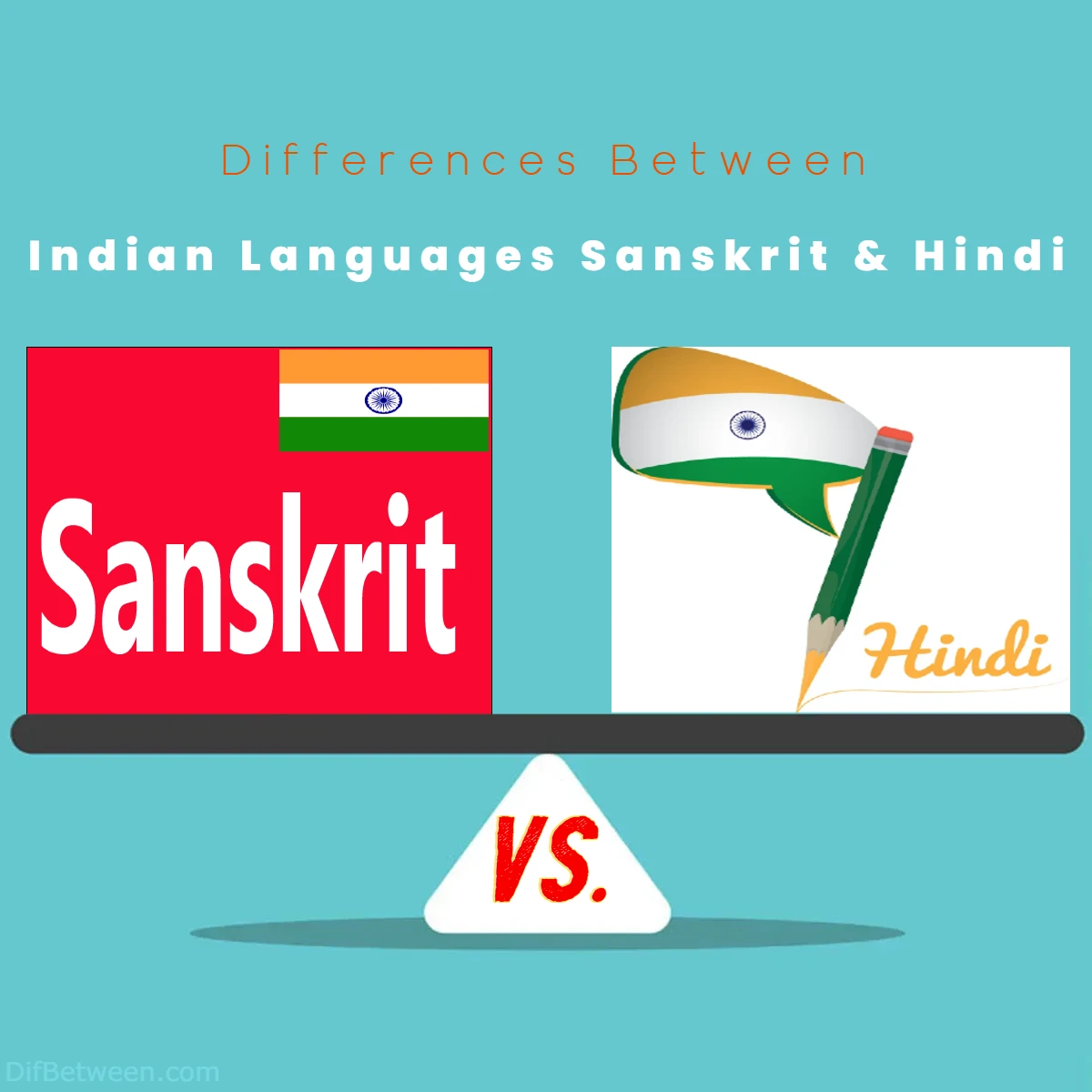
| Feature | Sanskrit | Hindi |
|---|---|---|
| Origins | Evolved from Vedic Sanskrit (circa 1500 BCE) | Developed from medieval Prakrit languages |
| Script | Devanagari script | Devanagari script |
| Grammar | Highly structured with complex declensions and conjugations | Structured but simpler conjugation patterns |
| Vocabulary | Ancient and rich, with a focus on spiritual and philosophical terms | Modern, with influences from Persian, Arabic, and English |
| Religious Significance | Sacred language for Hinduism and the Vedas | Used in religious texts and rituals, especially in North India |
| Literary Tradition | Epic poetry, philosophical texts, classical drama | Poetry, modern literature, and popular culture |
| Geographic Distribution | Limited to academic and religious contexts | Widely spoken in North India and recognized as an official language |
| Dialects | Generally uniform, with regional variations in pronunciation | Various regional dialects with distinct accents and vocabulary |
| Verb Conjugation | Complex conjugation patterns | Simpler verb conjugation |
| Influence on Other Languages | Influenced many Indian languages | Influenced other languages in North India |
| Literary Styles | Wide range of classical and poetic styles | Modern literature with diverse genres |
| Language Revival | Efforts to revive as a spoken language | Thriving as a spoken and literary language |
| Popularity in Education | Taught as a classical language in schools and universities | Widely taught in Indian schools and colleges |
| Global Relevance | Revered worldwide for its linguistic and philosophical contributions | Gained global recognition through Bollywood and the Indian diaspora |
Sanskrit, often referred to as the mother of Indian languages, takes us back in time to the ancient chants of the Vedas and the intricate poetry of Kalidasa. Its profound influence on philosophy and spirituality is undeniable. On the other hand, Hindi, a modern-day marvel, resonates with the vibrant melodies of Bollywood, the hustle and bustle of North India, and the warmth of everyday conversations.
Differences Between Indian Languages Sanskrit and Hindi
The main differences between Indian languages Sanskrit and Hindi lie in their origins, complexity, and cultural significance. Sanskrit, rooted in antiquity, serves as a classical and sacred language, characterized by intricate grammar, script, and a rich vocabulary focused on spiritual and philosophical terms. In contrast, Hindi, a modern vernacular language, boasts simpler grammar, shares the same Devanagari script as Sanskrit, and has a broader, everyday use in North India, particularly in Bollywood, literature, and daily communication. These distinctions highlight the profound contrast between Sanskrit’s ancient elegance and Hindi’s contemporary vibrancy within the tapestry of Indian languages.
A Glimpse into the History of Sanskrit and Hindi
Sanskrit: The Ancient Marvel
Sanskrit is often hailed as the mother of all Indian languages. Its history is deeply rooted in antiquity, with origins dating back to around 1500 BCE. The word “Sanskrit” itself means “refined” or “well-formed,” which aptly describes its intricate linguistic structure.
Ancient Origins: Sanskrit is a classical language of India and the liturgical language of Hinduism. It evolved from Vedic Sanskrit, the language of the ancient Indian scriptures known as the Vedas. These sacred texts, which include the Rigveda, Yajurveda, Samaveda, and Atharvaveda, were composed over centuries and transmitted orally before being written down in Sanskrit.
Cultural Significance: Sanskrit has played a pivotal role in shaping Indian culture and philosophy. Many ancient Indian texts, including the Upanishads, Puranas, and epics like the Mahabharata and Ramayana, were composed in Sanskrit. It remains the language of choice for religious and philosophical discourse in India.
Hindi: The Modern Vernacular
Hindi, on the other hand, is a more contemporary language compared to Sanskrit. Its development can be traced back to the 7th century CE. Hindi is part of the Indo-Aryan language family and has evolved through various stages.
Medieval Origins: Hindi’s roots can be found in the Prakrit languages and Apabhramsha, which were spoken in North India during the medieval period. Over time, it absorbed vocabulary from Persian, Arabic, and Turkish due to cultural interactions and the Mughal influence.
Emergence as a Modern Language: The modern form of Hindi, known as “Khari Boli,” emerged around the 18th century. It gained prominence during the British colonial era when it became a means of communication between Indians of different linguistic backgrounds.
Official Language Status: Hindi is one of the official languages of India, recognized alongside English. It serves as the primary language of governance and administration at the central level.
Linguistic Characteristics: Sanskrit vs Hindi
The Grammar and Structure
Sanskrit Grammar: Sanskrit is renowned for its intricate and highly structured grammar. It employs a system of declensions and conjugations, which means that the endings of words change to convey grammatical information like tense, gender, and case. This makes it a particularly expressive language.
Hindi Grammar: Hindi, while still possessing a complex grammar, is comparatively simpler than Sanskrit. It relies on postpositions rather than the extensive case system of Sanskrit. It also uses subject-verb-object (SVO) word order, making it more familiar to speakers of Western languages.
The Scripts
Sanskrit Script: Sanskrit is traditionally written in the Devanagari script. Devanagari is an abugida, meaning that each character represents a consonant with an inherent vowel sound, and additional diacritic marks are used to modify this sound. Devanagari is also the script of choice for writing Hindi.
Hindi Script: Hindi is primarily written in the Devanagari script as well. However, the script has some variations and additional characters to accommodate sounds specific to Hindi, such as retroflex consonants.
Vocabulary and Lexicon
Sanskrit Vocabulary: Sanskrit boasts a vast and ancient vocabulary, with a significant portion dedicated to spiritual and philosophical terms. It has influenced the lexicon of many Indian languages, including Hindi.
Hindi Vocabulary: Hindi’s vocabulary is more modern and has absorbed words from Persian, Arabic, English, and other languages over the centuries. This eclectic vocabulary reflects India’s historical interactions with various cultures.
Cultural Significance: Sanskrit vs Hindi
Religious Texts and Rituals
Sanskrit in Religion: Sanskrit holds a sacred position in Hinduism. Many religious rituals, prayers, and mantras are performed in Sanskrit. It’s also the language of choice for the recitation of Vedic hymns and religious ceremonies.
Hindi in Religion: While Hindi is not as deeply embedded in religious rituals as Sanskrit, it still plays a significant role in religious discourse, especially in North India. Many religious texts and bhajans (devotional songs) are composed in Hindi.
Literature and Classics
Sanskrit Literature: Sanskrit literature is a treasure trove of epic poetry, drama, philosophy, and scientific treatises. The Mahabharata, Ramayana, and works of Kalidasa are some of the finest examples of Sanskrit literature.
Hindi Literature: Hindi literature has a rich tradition of poetry and prose. Prominent Hindi writers like Premchand, Kabir, Tulsidas, and Harivansh Rai Bachchan have made enduring contributions to Indian literature.
Modern Media and Entertainment
Sanskrit in Modern Media: Sanskrit is not commonly used in modern media and entertainment due to its complexity. However, efforts have been made to revive it through initiatives like Sanskrit news broadcasts and Sanskrit-language schools.
Hindi in Modern Media: Hindi is a dominant language in Indian cinema, television, and music. Bollywood, India’s vibrant film industry, primarily produces films in Hindi, which are widely popular both within and outside India.
Geographic Distribution: Sanskrit vs Hindi
Regional Reach
Sanskrit’s Geographic Scope: Sanskrit, in its classical form, is no longer a spoken language. It is primarily used for religious and academic purposes. Its influence extends throughout India, but it lacks regional diversity.
Hindi’s Geographic Reach: Hindi is widely spoken in North India and serves as the lingua franca for many states in the northern and central regions. It is also one of the 22 scheduled languages of India, with a significant presence in government and education.
Dialects and Variations
Sanskrit Dialects: Classical Sanskrit has no regional dialects since it was intended to be a standardized, pan-Indian language. However, there are regional variations in pronunciation and vocabulary when it comes to chanting Vedic texts.
Hindi Dialects: Hindi has several regional dialects, including Bhojpuri, Awadhi, Rajasthani, and more. These dialects can differ significantly from standard Hindi, both in pronunciation and vocabulary.
Phonetics and Pronunciation
Sanskrit Phonetics: Sanskrit has a precise and intricate system of phonetics. It includes a wide range of sounds, including aspirated and retroflex consonants. The language places strong emphasis on proper pronunciation, and even a slight mispronunciation can alter the meaning of words or mantras.
Hindi Pronunciation: Hindi, while still having a diverse set of sounds, is generally considered more forgiving when it comes to pronunciation. Native speakers of Hindi may be less strict about correct enunciation compared to those of Sanskrit.
Verb Conjugation
Sanskrit Verb Conjugation: In Sanskrit, verbs are conjugated extensively to indicate tense, mood, person, and number. There are ten classes of verbs in Sanskrit, each with its own set of conjugation patterns, making it a formidable challenge for learners.
Hindi Verb Conjugation: Hindi, in contrast, has a simpler verb conjugation system. While there are tenses and moods, the conjugations are more regular and easier for beginners to grasp.
Influence on Other Languages
Sanskrit’s Influence: Sanskrit has left an indelible mark on many Indian languages, including Hindi. A significant portion of Hindi vocabulary is derived from Sanskrit, especially when it comes to technical, philosophical, and academic terms.
Hindi’s Influence: Hindi, as a widely spoken language, has also influenced other Indian languages, particularly in North India. It has contributed to the linguistic diversity of the subcontinent.
Literary Styles
Sanskrit Literary Styles: Sanskrit literature encompasses various styles, from epic poetry (mahakavya) to lyrical poetry (kavya). Each style follows strict rules of composition and meter, making Sanskrit literature a pinnacle of precision and artistry.
Hindi Literary Styles: Hindi literature is equally diverse, with genres ranging from poetry to short stories and novels. Modern Hindi literature often explores contemporary themes and issues, making it more accessible to a wide readership.
Language Revival and Preservation
Sanskrit Revival: Efforts have been made to revive Sanskrit as a spoken language, but it primarily survives as a classical and religious language. There are schools and institutions dedicated to the study of Sanskrit, preserving its linguistic and cultural heritage.
Hindi Preservation: Hindi, being a widely spoken language, faces fewer challenges in terms of preservation. However, there are initiatives to document and promote regional dialects of Hindi, ensuring the vitality of the language across India.
Popularity in Education
Sanskrit in Education: Sanskrit is taught as a classical language in many Indian schools and universities. It is often chosen as an optional subject for its historical and cultural significance.
Hindi in Education: Hindi is a prominent medium of instruction in North India, and it is one of the most commonly taught languages in Indian schools. It serves as a bridge language for students from diverse linguistic backgrounds.
Global Relevance
Sanskrit’s Global Presence: Sanskrit’s global influence extends beyond India. It has inspired scholars and linguists worldwide and has contributed to the study of linguistics, philosophy, and comparative religion.
Hindi’s Global Impact: Hindi, through Bollywood and the Indian diaspora, has gained global recognition. It is spoken by millions of people around the world and is an essential part of India’s soft power.
Indian Languages Sanskrit or Hindi: Which One is Right Choose for You?
India, known for its linguistic diversity, offers a fascinating choice between Sanskrit and Hindi, each with its own unique characteristics and cultural significance. Whether you’re considering learning a new language, exploring Indian culture, or simply curious, this guide will help you decide which language aligns better with your interests and goals.
Sanskrit: The Language of Tradition and Spirituality
For the Language Enthusiast:
If you’re passionate about linguistics and enjoy delving into the intricacies of grammar and syntax, Sanskrit could be your calling. It boasts one of the most structured and precise grammatical systems in the world.
For the Spiritual Seeker:
Sanskrit is the language of ancient Indian scriptures, including the Vedas, Upanishads, and Bhagavad Gita. If you have a keen interest in spirituality, yoga, or meditation, learning Sanskrit will allow you to explore these disciplines in their original language.
For Academic Pursuits:
Sanskrit is taught in many Indian schools and universities as a classical language. If you’re pursuing academic studies related to Indian culture, philosophy, or history, a knowledge of Sanskrit can be invaluable.
For Cultural Immersion:
Immerse yourself in the rich cultural heritage of India. Sanskrit opens doors to classical literature, poetry, and performing arts, providing a deeper understanding of India’s traditions.
For a Unique Challenge:
If you enjoy a linguistic challenge and are looking for something distinct, Sanskrit’s complex grammar and script offer an intellectually stimulating experience.
Hindi: The Language of Modern India
For Practical Communication:
Hindi is one of the most widely spoken languages in India. If your goal is to communicate effectively with a broad range of people during your travels or for business, Hindi is a practical choice.
For Bollywood and Pop Culture:
Hindi is the language of Bollywood, India’s vibrant film industry. If you’re a fan of Indian cinema, music, or contemporary literature, learning Hindi will enhance your appreciation of these cultural facets.
For Traveling in India:
Traveling through North India becomes more enjoyable when you can converse in Hindi. It opens up opportunities for authentic interactions with locals and a deeper exploration of the region.
For Business and Work:
Hindi is often used in business and government settings in India. If you plan to work in or with Indian companies, knowing Hindi can be a professional advantage.
For a Smoother Transition:
If you’re new to Indian languages, Hindi’s relatively simpler grammar and script make it an accessible starting point.
Conclusion: The Choice is Yours
The choice between Sanskrit and Hindi ultimately depends on your interests, goals, and the experiences you seek. Sanskrit offers a window into India’s ancient wisdom and spiritual heritage, while Hindi connects you with the dynamic, modern face of the country.
Whichever language you choose, both Sanskrit and Hindi have their own unique charm and cultural relevance. Learning either of them can be a rewarding journey that deepens your understanding of India’s diverse and fascinating linguistic tapestry. So, whether you’re drawn to the timeless mystique of Sanskrit or the vibrant pulse of Hindi, your exploration of Indian languages promises to be a remarkable adventure.
FAQs
Sanskrit has deep historical roots and is considered the mother of many Indian languages. It is associated with ancient texts and scriptures. Hindi, on the other hand, emerged in the medieval period and is a prominent modern Indian language.
Yes, both Sanskrit and Hindi are written in the Devanagari script. While the script is largely similar, Hindi has additional characters to accommodate its specific sounds.
Sanskrit is known for its intricate grammar with extensive declensions and conjugations. In contrast, Hindi has a simpler and more regular grammatical structure, making it easier for beginners.
Sanskrit is generally uniform in its classical form, with regional variations in pronunciation. Hindi, however, has numerous regional dialects with distinct accents and vocabulary.
Sanskrit has a significant cultural role as the language of ancient religious texts and classical literature. It is used in rituals and scholarly discourse. Hindi plays a vital role in modern Indian culture, especially in Bollywood, literature, and everyday communication.
Hindi is the more widely spoken language in India, particularly in the northern and central regions. Sanskrit, in its classical form, is not spoken as a mother tongue but is used in academic and religious contexts.
To learn Sanskrit or Hindi, you can consider enrolling in language courses, both online and offline. There are also numerous resources, books, and language-learning apps available to help you get started.
Sanskrit has influenced linguistic and philosophical studies worldwide. Hindi has gained global recognition through Bollywood and the Indian diaspora, making it more widely known internationally.
Read More:
Contents
- Differences Between Indian Languages Sanskrit and Hindi
- A Glimpse into the History of Sanskrit and Hindi
- Linguistic Characteristics: Sanskrit vs Hindi
- Cultural Significance: Sanskrit vs Hindi
- Geographic Distribution: Sanskrit vs Hindi
- Phonetics and Pronunciation
- Verb Conjugation
- Influence on Other Languages
- Literary Styles
- Language Revival and Preservation
- Popularity in Education
- Global Relevance
- Indian Languages Sanskrit or Hindi: Which One is Right Choose for You?
- FAQs






